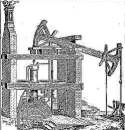The Edge Seams of Midlothian
and the estates of Duddingston, Niddry, Edmonstone, Woolmet
Prior to 1800, most of the coal mined on these estates were from the 'edge' seams. After that time, the newer pits on these estates were more to the east to work the deeper (and thicker) 'flat' seams. Below I have confined myself to the history of these pits when working the 'edge' seams.
The coalworks of Duddingston, Niddry, Edmonston and Woolmet were at one time all connected by a tunnel or "level" beginning from the sea shore at Joppa and running underground for 3 miles. It allowed all these coalworks to be drained of water without the need for pumping engines or other mechanical devices. It was very successful for a time but by the end of the century most of these coalworking were abandoned.
Duddingston (Abercorn)
At the begnning of the 18th century, the Duddingston estate was owned by the 3rd Duke of Argyll. The working were drained by a bucket and chain method (a continuous chain with buckets attached to lift the water. The number of buckets attached could be altered depending on the amount of water to be drained).
- 1745 - The estate was bought by John Hamilton, 8th Duke of Abercorn. Almost immediately he leased it to John Biggar of Woolmet who began work on the sea level to allow water to be drained without any need for mechanical devices. In 1748, Biggar also leased the neighbouring estate of Niddry allowing him to extend the level into that estate.
- 1763 - The lease ran out and the Duke of Abercorn took charge. He had a fire engine erected to allow the coalworks to be worked down to a depth of 53 fathoms. Later a second fire engine was erected to extend the depth to 60 fathoms and also allow coal on the neighbouring Brunstane estate to be worked. About 220 people were employed around this time.
- 1790 - On 20 March the coalworks were closed due to drainage and geological problems.
- c.1800 - £13,000 was spent on the pit erecting new larger engines but the coalworks were abandoned as not profitable.
Niddry
This estate was the property of the Wauchope family of Edmonstone. Like all the other edge seams it was probably worked on a very small scale in earlier times.
- 1696 April - New coalworks started. It was drained the same way as Duddingstion using a bucket and chain method. Power for the bucket and chain machinery was provided by a horse gin (5 horses were kept at the coalworks for this purpose). The coal itself was brought to the surface by bearers climbing stair pits.
- 1748 - John Biggar of Woolmet granted a 19 year lease. Biggar had also leased Duddingston coalworks 3 years earlier and this allowed him to extend the level he was constructing from the sea up to the Niddry coal. The level had already reached into the Niddry estate by 1752. Drainage of the coalworks using the sea level enabled the coal to be worked to a far greater depth than before.
- 1762 - After Biggar's death the lease of the coal he was working eventually passed to Sir Archibald Hope who continued to work the coal and erected a fire engine at some time before 1767.
- 1767 - Hope's lease ended and Wauchope granted new lease to Peter Hunter.
Edmonston
This estate was also owned by the Wauchopes. It was probably drained in the same way as the others.
- 1725-26 - A very large fire engine (28" brass cylinder) was erected. This is an engraving of the engine at Edmonston.
- 1740 - Thirty eight year lease granted to Sir John Hope [of the edge seams?]. It may have been given up before it's full term if the workable coal was exhausted.
- 1766 April - The 5 'flat' coal seams leased by Hope flooded.
- 1768/9 - Wauchope gave Hope a new lease of the 'edge' seams. These had already been leased by Hope before, and were probably worked out. On this ocassion, the purpose of the lease was to acquire the right to the colliers bound to Edmonston and use them at his other leased coalworks and not Edmonston itself.

See the Edmonston 'Coal Check Bill' - for the week of 14th January 1760, showing the coal produced by each collier
Woolmet
This estate was bought by Major Biggar in 1645. He soon began to work two of the thick flat seams - the splint coal and the Rough Coal. Drainage was by means of water levels and coalworking seems to have continued almost uninterrupted.
- 1768 - Leased by Hope for three 19 year leases. He erected a fire engine on his own property at Harrylaw adjoining the Woolmet estate to help drain the coal seams (probably the flat seams).
[I can find little first hand information on Woolmet and some of it is contradictory so I've just done this very brief entry]